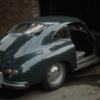I visited Rich MacKoul last night for some additional info/measurements on his dash for @flatfourfan in South Africa and while there I took these photos of Rich's dash so we can all see what an original '55 looks like. First, the corner trim with the door closed for the relationship of the dash to door trim - Also note that the front socket for the side window is elongated to make installing the windows easier. HIs corner posts are about the same as ours, but the windshield top frame is much more robust than what I got from CMC:
Next, same shot with the door opened to see how the corner of the dash pad/trim is finished off:
And lastly, a shot of the dash trim and the pad in the middle. My guess is that the pad is 1/4" - 3/8" thick and relatively soft (My CMC pad is 3/4" thick and relatively hard).







